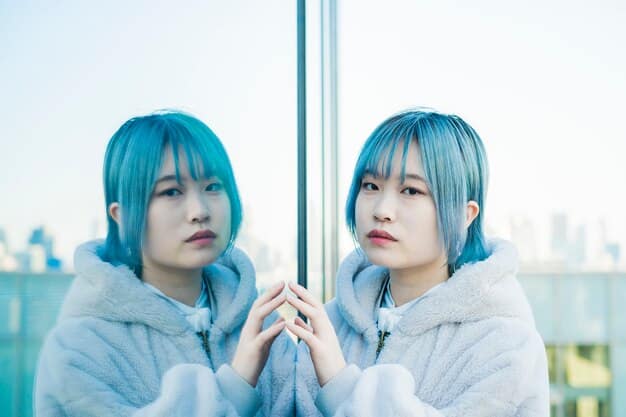Korean Drama Dubbing vs. Subtitles: What US Viewers Prefer

The debate between Korean drama dubbing and subtitles among US viewers centers on accessibility versus authenticity, with subtitles generally preferred for preserving the original performance and cultural nuances, though dubbing expands viewership by eliminating the language barrier.
For US viewers diving into the captivating world of Korean dramas, one question often arises: is it better to watch with dubbing or subtitles? This debate between Korean drama dubbing vs. subtitles: which is more popular among US viewers? touches on everything from authenticity to accessibility.
Understanding the Allure of Korean Dramas in the US
Korean dramas, often referred to as K-dramas, have surged in popularity in the United States. Their compelling storylines, high production values, and unique cultural insights resonate with a diverse audience. But what exactly makes them so appealing?
Cultural Exploration
K-dramas offer a window into Korean culture, showcasing traditions, social norms, and lifestyle. For many viewers, this cultural immersion is a significant part of the entertainment.
Relatable Themes
Despite the cultural differences, K-dramas often explore universal themes such as love, family, friendship, and ambition. These relatable themes make the stories accessible and emotionally engaging for US viewers.
- Unique Storytelling: K-dramas often feature fresh and innovative narratives compared to typical Western television.
- High Production Quality: The attention to detail in cinematography, costume design, and set design enhances the viewing experience.
- Emotional Resonance: The emphasis on character development and emotional depth pulls viewers into the story.
The increasing accessibility of K-dramas through streaming platforms has further fueled their popularity. As more Americans discover these shows, the debate over how best to enjoy them—dubbed or subtitled—continues.

Dubbing: The Convenience Factor
Dubbing involves replacing the original Korean dialogue with English, allowing viewers to understand the story without reading subtitles. This method offers convenience, but also sparks debate about the viewing experience.
Accessibility for All
Dubbing makes K-dramas accessible to a wider audience. Those who struggle with reading subtitles, have visual impairments, or prefer multitasking can enjoy K-dramas without the constant need to focus on the text.
Eliminating Distractions
Some viewers find that reading subtitles distracts them from the visual aspects of the show. Dubbing removes this distraction, allowing viewers to fully immerse themselves in the scenery, costumes, and acting.
While dubbing offers clear advantages in terms of accessibility and convenience, it often faces criticism for potentially altering the original tone and nuances of the performances. This trade-off is a key consideration for many viewers.
Subtitles: Preserving Authenticity
Subtitles provide a direct translation of the original Korean dialogue, displayed at the bottom of the screen. This method is often favored by purists who want to experience the drama as intended by its creators.
Original Performances
Subtitles allow viewers to hear the actors’ original voices and intonations, preserving the emotional impact of their performances. Dubbing, on the other hand, can sometimes flatten or misrepresent these nuances.
Cultural Nuances
Subtitles can convey cultural nuances that are difficult to capture in dubbing. Idioms, honorifics, and other cultural references are often explained through subtitles, providing a deeper understanding of the context.
- Learning Opportunities: Watching with subtitles can help viewers learn basic Korean phrases and gain familiarity with Korean culture.
- Accuracy: Subtitles generally offer a more accurate representation of the original dialogue compared to dubbing, which may involve adaptations for lip-syncing.
- Personal Preference: Many viewers simply prefer the experience of hearing the original language, even if they don’t understand it.
Despite the advantages of authenticity and accuracy, subtitles may not be suitable for all viewers or viewing situations. Some find them distracting or difficult to follow, particularly during fast-paced scenes.

US Viewers’ Preferences: A Mixed Bag
When it comes to Korean drama dubbing vs. subtitles: which is more popular among US viewers?, there’s no definitive answer. Preferences vary based on individual viewing habits, language skills, and priorities regarding authenticity versus convenience.
Survey Insights
Surveys and online polls often reveal a mixed bag of preferences. While many viewers lean towards subtitles for their accuracy, a significant portion appreciates the accessibility of dubbing.
Factors Influencing Choice
Several factors can influence a viewer’s choice between dubbing and subtitles, including:
- Language Proficiency: Viewers with some knowledge of Korean may prefer subtitles to enhance their understanding.
- Viewing Environment: In noisy environments or while multitasking, dubbing may be more convenient.
- Personal Preferences: Some viewers simply prefer one method over the other, regardless of the specific drama or situation.
Ultimately, the choice between dubbing and subtitles is a personal one. Both methods offer valid ways to enjoy K-dramas, and the best option depends on individual needs and preferences.
The Impact of Streaming Services
Streaming services have played a pivotal role in shaping the landscape of K-drama viewing in the US. Platforms like Netflix, Viki, and Hulu offer a wide selection of K-dramas with both dubbing and subtitle options, catering to diverse viewer preferences.
Increased Accessibility
The availability of K-dramas on popular streaming platforms has made them more accessible to a broader audience. This increased exposure has fueled the debate over dubbing versus subtitles, as more viewers encounter these options.
Variety of Options
Streaming services often provide multiple subtitle tracks in different languages, as well as dubbed versions in English and other languages. This variety allows viewers to customize their viewing experience according to their preferences.
The impact of streaming services extends beyond accessibility and variety. These platforms also influence the production and distribution of K-dramas, with some investing in original productions specifically targeted at international audiences.
The Future of K-Drama Viewing in the US
As K-dramas continue to gain popularity in the US, the future of their viewing experience is likely to be shaped by technological advancements, evolving viewer preferences, and industry trends.
AI-Powered Dubbing
Artificial intelligence (AI) is poised to transform the dubbing process. AI-powered dubbing tools can generate more accurate and natural-sounding translations, potentially bridging the gap between convenience and authenticity.
Personalized Subtitles
Future streaming platforms may offer personalized subtitle options, allowing viewers to customize the font size, color, and positioning of subtitles according to their individual needs and preferences.
- Interactive Learning: Imagine subtitles that provide real-time translations and cultural explanations, turning K-drama viewing into an interactive learning experience.
- Community Engagement: Online forums and social media platforms will continue to foster discussions and debates about the best way to enjoy K-dramas, influencing industry trends and viewer preferences.
- Globalization: The increasing globalization of entertainment will further blur the lines between cultures and languages, making K-dramas an integral part of the global media landscape.
The future of K-drama viewing in the US is bright, with exciting possibilities on the horizon. As technology evolves and viewer preferences continue to shape the industry, the debate over dubbing versus subtitles will undoubtedly remain a central topic of discussion.
| Key Aspect | Brief Description |
|---|---|
| 🎧 Dubbing | Offers convenience and accessibility by replacing original dialogue. |
| 💬 Subtitles | Preserves original performances and cultural nuances effectively. |
| 📺 Streaming Impact | Streaming platforms increase K-drama accessibility with varied viewing. |
| 🤖 AI Dubbing | AI may enhance dubbing accuracy and naturalness in the future. |
Frequently Asked Questions
K-dramas resonate with US viewers due to unique storylines, high production values, and insights into Korean culture. They often explore universal themes, making them relatable.
Dubbing enhances accessibility for those who struggle with subtitles or prefer multitasking. It removes distractions, allowing full visual immersion in the drama.
Subtitles preserve the original performances and cultural nuances lost in dubbing. Viewers can hear original voices and gain a deeper understanding.
Streaming services such as Netflix and Viki offer K-dramas with both dubbing and subtitle options, broadening accessibility and catering to diverse preferences.
AI-powered dubbing could generate more accurate and natural translations, potentially making dubbing as enjoyable as watching with subtitles.
Conclusion
In the end, the choice between watching Korean dramas with dubbing or subtitles comes down to personal taste and priorities. While dubbing certainly broadens accessibility, subtitles often win out for those seeking an authentic experience. As technology continues to evolve, perhaps future innovations will bridge the gap, offering the best of both worlds to US viewers.





